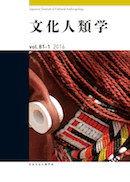Volume 78, Issue 1
Displaying 1-27 of 27 articles from this issue
- |<
- <
- 1
- >
- >|
-
Article type: Cover
2013Volume 78Issue 1 Pages Cover1-
Published: June 30, 2013
Released on J-STAGE: April 03, 2017
Download PDF (21545K) -
Article type: Cover
2013Volume 78Issue 1 Pages Cover2-
Published: June 30, 2013
Released on J-STAGE: April 03, 2017
Download PDF (21545K) -
Article type: Appendix
2013Volume 78Issue 1 Pages App1-
Published: June 30, 2013
Released on J-STAGE: April 03, 2017
Download PDF (69K) -
Article type: Article
2013Volume 78Issue 1 Pages 1-25
Published: June 30, 2013
Released on J-STAGE: April 03, 2017
Download PDF (2666K) -
Article type: Article
2013Volume 78Issue 1 Pages 26-49
Published: June 30, 2013
Released on J-STAGE: April 03, 2017
Download PDF (2266K) -
Article type: Article
2013Volume 78Issue 1 Pages 50-56
Published: June 30, 2013
Released on J-STAGE: April 03, 2017
Download PDF (811K) -
Article type: Article
2013Volume 78Issue 1 Pages 57-80
Published: June 30, 2013
Released on J-STAGE: April 03, 2017
Download PDF (2420K) -
Article type: Article
2013Volume 78Issue 1 Pages 81-98
Published: June 30, 2013
Released on J-STAGE: April 03, 2017
Download PDF (1759K) -
Article type: Article
2013Volume 78Issue 1 Pages 99-110
Published: June 30, 2013
Released on J-STAGE: April 03, 2017
Download PDF (1318K) -
Article type: Article
2013Volume 78Issue 1 Pages 111-126
Published: June 30, 2013
Released on J-STAGE: April 03, 2017
Download PDF (1621K) -
Article type: Article
2013Volume 78Issue 1 Pages 127-130
Published: June 30, 2013
Released on J-STAGE: April 03, 2017
Download PDF (526K) -
Article type: Article
2013Volume 78Issue 1 Pages 130-134
Published: June 30, 2013
Released on J-STAGE: April 03, 2017
Download PDF (675K) -
Article type: Article
2013Volume 78Issue 1 Pages 134-137
Published: June 30, 2013
Released on J-STAGE: April 03, 2017
Download PDF (546K) -
Article type: Article
2013Volume 78Issue 1 Pages 137-141
Published: June 30, 2013
Released on J-STAGE: April 03, 2017
Download PDF (663K) -
Article type: Article
2013Volume 78Issue 1 Pages 141-144
Published: June 30, 2013
Released on J-STAGE: April 03, 2017
Download PDF (544K) -
Article type: Article
2013Volume 78Issue 1 Pages 144-146
Published: June 30, 2013
Released on J-STAGE: April 03, 2017
Download PDF (413K) -
Article type: Appendix
2013Volume 78Issue 1 Pages 147-151
Published: June 30, 2013
Released on J-STAGE: April 03, 2017
Download PDF (358K) -
Article type: Appendix
2013Volume 78Issue 1 Pages 151-
Published: June 30, 2013
Released on J-STAGE: April 03, 2017
Download PDF (26K) -
Article type: Appendix
2013Volume 78Issue 1 Pages 152-154
Published: June 30, 2013
Released on J-STAGE: April 03, 2017
Download PDF (261K) -
Article type: Appendix
2013Volume 78Issue 1 Pages 154-
Published: June 30, 2013
Released on J-STAGE: April 03, 2017
Download PDF (71K) -
Article type: Appendix
2013Volume 78Issue 1 Pages 155-
Published: June 30, 2013
Released on J-STAGE: April 03, 2017
Download PDF (91K) -
Article type: Appendix
2013Volume 78Issue 1 Pages 156-
Published: June 30, 2013
Released on J-STAGE: April 03, 2017
Download PDF (76K) -
Article type: Appendix
2013Volume 78Issue 1 Pages App2-
Published: June 30, 2013
Released on J-STAGE: April 03, 2017
Download PDF (36K) -
Article type: Appendix
2013Volume 78Issue 1 Pages App3-
Published: June 30, 2013
Released on J-STAGE: April 03, 2017
Download PDF (36K) -
Article type: Appendix
2013Volume 78Issue 1 Pages App4-
Published: June 30, 2013
Released on J-STAGE: April 03, 2017
Download PDF (36K) -
Article type: Cover
2013Volume 78Issue 1 Pages Cover3-
Published: June 30, 2013
Released on J-STAGE: April 03, 2017
Download PDF (51K) -
Article type: Cover
2013Volume 78Issue 1 Pages Cover4-
Published: June 30, 2013
Released on J-STAGE: April 03, 2017
Download PDF (51K)
- |<
- <
- 1
- >
- >|
